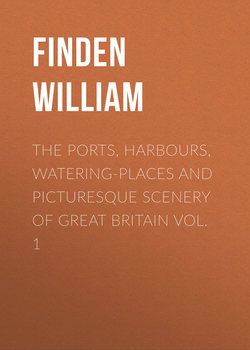Читать книгу The Ports, Harbours, Watering-places and Picturesque Scenery of Great Britain Vol. 1 - Finden William - Страница 12
WHITBY
ОглавлениеThis engraving of Whitby, from a drawing by Harding, presents a view of the entrance to the harbour, as seen from the northward. Towards the middle of the plate is seen the end of the east pier; on the top of the cliff are the ruins of the abbey and the parish church; while, farther to the right, part of the town is perceived.
Whitby is in the North Riding of Yorkshire, and lies about 246 miles north of London, 22 north-north-west of Scarborough, and 47 north-east of York. It is chiefly built on the sloping banks of the river Esk, by which it is divided into two parts; that on the west side being the most populous. The opposite parts of the town are connected by means of a bridge, the middle of which is moveable for the purpose of allowing ships to pass through. In the old bridge, which has been pulled down, the opening in the middle was upon the principle of a drawbridge, in which the roadway is raised and lowered by means of beams and chains. At high-water the river above the bridge expands into a spacious harbour, where ships can lie in perfect security; but at ebb tide, except in the mid-channel, the harbour is nearly dry. In the outer harbour, as it is called, below the bridge, vessels cannot ride with safety in gales of wind upon the land.
The piers at the entrance to Whitby harbour are not built and maintained at the sole expense of the place, but by a duty on coals shipped at Newcastle, Sunderland, Blyth, and their dependencies – Yarmouth vessels only being exempt – and the sum thus raised amounts to upwards of £2,000 per annum. It is doubtless a great advantage to the people of Whitby to have their piers built and kept in repair at the expense of other ports; but it is equally certain that the same sum might be employed more to the advantage of those by whom it is paid in improving other places – Scarborough and Burlington, for instance – as harbours of refuge on the eastern coast. In a gale of wind from the eastward, Whitby is perhaps one of the most dangerous harbours that a vessel can attempt to take between Yarmouth roads and the Frith of Forth, and captains of coasting vessels cannot be too frequently warned to avoid it. As the flood tide sets strong to the southward across the entrance to the harbour, vessels in attempting to enter with a gale of wind from the north-east are extremely liable to be driven on the rocks and wrecked at the foot of the cliff beyond the east pier.
A singular customary duty, called "making the penny-stake hedge," is annually performed at Whitby, by certain tenants of the Lord of the Manor. It consists in driving a certain number of stakes, which, according to the ancient prescribed form, were to be cut with a knife of the value of one penny, on the shore of the south side of the Esk, at low-water mark, at nine o'clock on the morning of the day before Ascension-day, while a man with a horn blows, "Out on you! Out on you!" to the shame of the persons whose duty it is to drive the stakes. When it shall be full sea or high-water at nine o'clock on the day of performing this service, it was to cease; but as Ascension-day is regulated by the change of the moon this can never happen. This custom is of great antiquity, as the horngarth, the enclosure formed by the stakes, is mentioned about 1315 in the registers of the Abbey, in an account of certain disputes between the abbot, Thomas de Malton, and Alexander de Percy, of Sneaton. Tradition reports that this custom was imposed as a penance on three persons of the families of Percy, Bruce, and Allatson, who held lands of the Abbey, for having killed a hermit in the chapel of Eskdale-side, when hunting a wild boar which had there taken refuge. The penance imposed was the tenure by which they and their successors were to hold the Abbey lands.
Leland, who visited Whitby a few years before the suppression of the monastery, describes it as a "great fisher town;" and he mentions that when he was there a new quay and pier were in course of erection. Until the establishment of the alum works in its neighbourhood, towards the latter end of the reign of Queen Elizabeth, Whitby appears to have been a place of little trade. As this new branch of commerce extended, the trade and population of Whitby steadily increased until it has attained its present importance.
